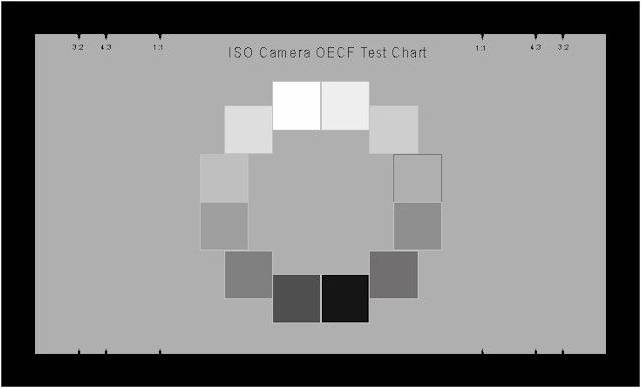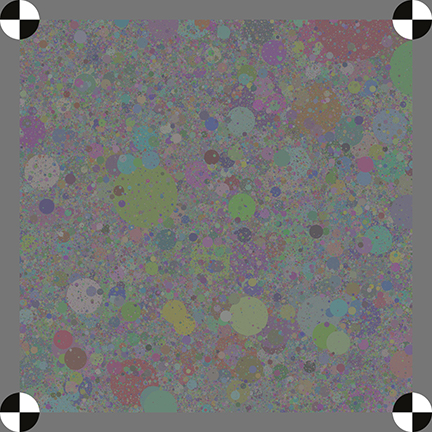Digital Camera Noise and Texture Measurements
This webpage describes ISO 15739:2023, Photography — Electronic still-picture imaging — Noise measurements. ISO 15739 has been developed by ISO/TC 42. ISO:15739:2023 is the latest 4th edition, which incorporates many technical changes from the 3rd edition, ISO 15739:2017. This webpage includes background information on the standard, and a link to download the software which can be used to perform the measurements defined in ISO 15739:2023. Further, this webpage provides the link to the test files for use with ISO/TS 19567-2, Photography — Digital cameras — Part 2: Texture analysis using stochastic pattern.
We appreciate your using these links. The cost is the same as purchasing the standards directly from ANSI and, by using the link, IS&T receives a commission that goes directly to support the ISO/TC 42 standards program.
Purchase ISO 15739 from the US ANSI website.
A. ISO 15739 Index
1. Why measure noise?
Noise is defined as unwanted variation in the response of an imaging system. Noise is an important attribute of digital cameras, such as digital still cameras and camera phones. ISO 15739:2023 provides users and manufacturers with a standard method for measuring this important image quality attribute.
Noise is measured using a test chart defined in ISO 14524. (Click to go to the US ANSI website to purchase ISO 14524.) Note that the image below is a representation showing one layout for an ISO 14524 test chart. The image shown is uncalibrated and cannot be used for ISO 14524 testing purposes.
 OECF test chart defined in ISO 14524
OECF test chart defined in ISO 145242. Camera noise measurements:
The visibility of noise to human observers depends on the magnitude of the noise, the apparent tone of the area containing the noise, and the spatial frequency of the noise. The magnitude of the noise present in an output representation depends on the noise present in the acquired image data and the contrast amplification or gain applied to the data in producing the output. The noise visibility is different for the luminance (or monochrome) channel and the color (or color difference) channels. ISO 15739:2023 accounts for these factors in measuring and reporting the camera noise.
Camera dynamic range measurements: Measurement of camera dynamic range is closely associated with measurement of camera noise. ISO 15739:2023 defines Digital Still Camera (DSC) dynamic range to be the ratio of the input signal saturation level to the minimum input signal level that can be captured with a signal-to-temporal noise ratio of at least 1. ISO 15739:2023 specifies how to measure and report DSC dynamic range.
The standard includes a number of important annexes:
- Annex A specifies the method for determining the components of the digital camera noise from a number of samples.
- Annex B describes a procedure for measuring the visual noise using a human visual model that aims to predict the perceived quality of the image.
- Annex C specifies a method for removing low frequency variations from the image.
- Annex D provides a recommended step-by-step procedure for determining the signal-to-noise ratio.
- Annex E describes recommendations for practical viewing conditions for various output media.
- Annex F introduces perceptually uniform mapping of visual noise to noisiness JND.
3. Measurement software:
Experts from ISO/TC 42 have developed software for performing the noise measurements, described in normative Annex B and informative Annex F of ISO 15739:2023.
Click to download a zip file of software for ISO/TC 42/WG 18 15739:2023 Annex B.
Click to download a zip file of software for ISO/TC 42/WG 18 15739:2023 Annex F JND mapping.
Note: Matlab is required to run the software — it is not compiled. This reference implementation is meant to be reviewed and implemented by software developers.
4. Related papers published by IS&T
The following are links to IS&T and SPIE papers which describe the development of aspects of this noise measurement standard.
- Kelly S. C., Keelan B.W., ISO 12232 Revision: Determination of Chrominance Noise Weights for Noise-Based ISO Calculation, January 2005, SPIE Image Quality and System Performance II.
- Aoyama, K ., Enomoto, H. and Hung, P.C., An evaluation of scanner noise based upon a human visual model, IS&T’s 49th Annual Conference, (1996), pp. 322–324.
- Wueller D., Matsui A., Katoh N., Visual noise revision for ISO 15739, IS&T International Symposium on Electronic Imaging, 2019, Image Quality and System Performance XVI, pp. 315-1-315-7.
- Matsui A., Katoh N., Wueller D., Experimental study for revising visual noise measurement of ISO 15739, IS&T International Symposium on Electronic Imaging, 2021, Image Quality and System Performance XVIII, pp. 219-1-219-7.
- Bourbon T., Hillairet C.S., Pochon B., Guichard F., New visual noise measurement on a versatile laboratory setup in HDR conditions for smartphone camera testing, IS&T International Symposium on Electronic Imaging, 2022, Image Quality and System Performance XIX, pp. 313-1-313-8.
B. ISO/TS 19567-2
So-called texture loss is a critical parameter in the objective image quality assessment of today's cameras. In particular, cameras build into mobile phones show significant loss of low contrast, fine details which are hard to describe using standard resolution measurement procedures. The combination of very small form factor and high pixel count leads to a high demand of noise reduction in the signal-processing pipeline of these cameras. Different working groups within ISO and IEEE have investigated methods to describe the texture loss with an objective method. The "dead leaves" pattern, as it is known, has been used for quite a while in this context. ISO/TS 19567-2, Photography - Digital cameras - Part 2: Texture analysis using stochastic pattern uses a new intrinsic approach that solves the open issues of the original approach that could be influenced by noise and artifacts. For background, refer to the paper linked below in the proceedings of the SPIE/IS&T Electronic Imaging Symposium 2015.
ISO/TS 19567-2 specifies the measurement of texture in images captured by a digital still camera. Within that technical specification a test chart is defined for the measurement. (Click to go to the US ANSI website to purchase ISO/TS 19567-2.)
 ISO TS 19567-2 Texture chart, available for download below
ISO TS 19567-2 Texture chart, available for download below.
To ensure that everyone uses the same original chart the ISO/TC 42 committee provides the original data of that "Dead Leaves" chart in both vector and high resolution pixel format. Click HERE to download the zip file containing both images.
Related SPIE/IS&T Electronic Imaging 2015 proceedings paper:
Image quality assessment using the dead leaves target: experience with the latest approach and further investigations, Uwe Artmann, Image Engineering GmbH & Co. KG (Germany), Proceedings Volume 9404, Digital Photography XI; 94040J (2015) (https://doi.org/10.1117/12.2079609).

